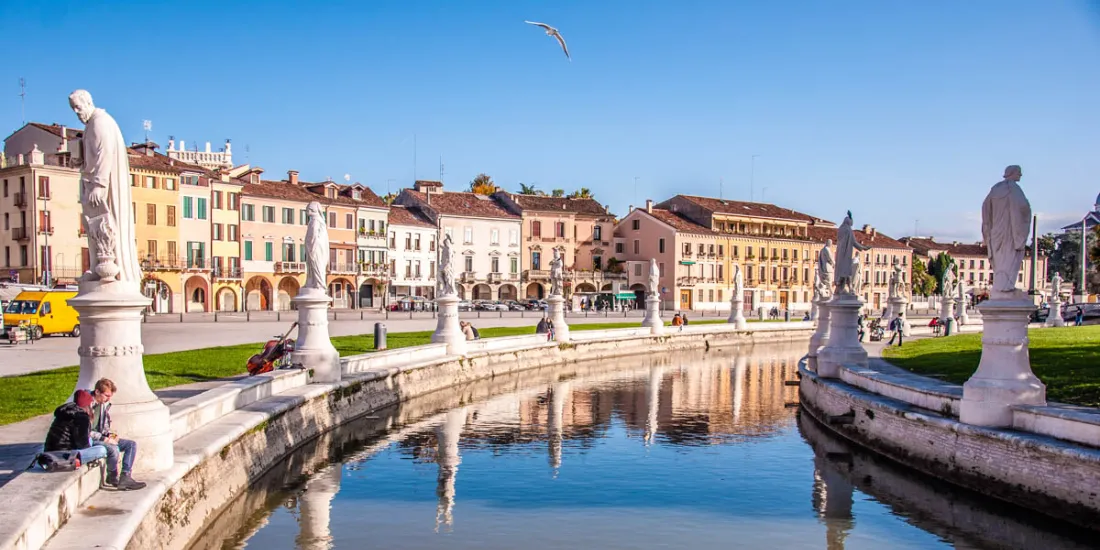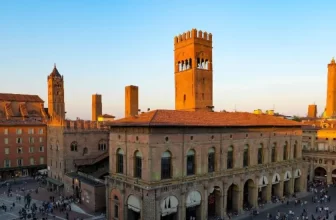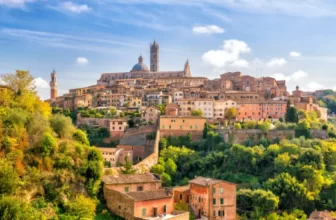
Opening Scene: Your First Day in Padua
The first thing that hits you when you step out of the train station in Padua isn’t the heat or the hustle-it’s the quiet charm that kind of sneaks up on you. You’ll hear the soft swish of bikes crisscrossing cobblestone streets, a hiss from a passing espresso machine somewhere, and church bells echoing off red-brick buildings. That’s your welcome soundtrack to student life in Padua.
I still remember rolling my suitcase across the old stone pavement, trying to look calm while silently panicking about not speaking Italian (yet). It was late September-still warm enough to sweat in jeans, but cool enough at night to need a sweater. And the air? It smells like a mix of fresh bread, exhaust, and a bit of history.
I found my first coffee spot kind of by accident. A tiny bar near Piazza Garibaldi where the barista didn’t speak English, but somehow I ended up with exactly what I needed-a shot of espresso and a spot to sit. No Wi-Fi, no tourists.
If you’re seriously looking for a study guide in Padua, this is that no-BS roadmap with everything I wish someone had told me before showing up. From real cost of living to where students actually live, to how the visa stuff really works-this guide will walk you through it all.
Let’s break it down. Seriously. You’ve got time before the 2026 intake, and trust me-you’ll want to plan early.
Why Study in Padua in 2026?
Most people don’t immediately think Padua (or Padova, in Italian) when they picture studying in Europe… unless they’ve really done their research.
But here’s the thing: Padua is home to one of the oldest universities in the world, the University of Padua, founded in 1222. The legacy is real, but what blows students away today is how that old-soul history meets cutting-edge research, especially in medicine, law, philosophy, engineering, and agricultural sciences.
So, why 2026?
- Scholarships are expanding for international students (including those from the Global South, underrepresented nationalities, and STEM backgrounds).
- The Italian government has streamlined student visa policies post-immigration reform in 2023. Turnaround times are faster, and work limits have eased up.
- This is one of the most affordable student cities in northern Italy, especially compared to Milan or Florence.
- Italy saw a 15% jump in international student intake between 2022–2024. Padua is now near the top destinations-yet without the overwhelm of big metropolises.
Bonus? You’re only 30 minutes from Venice, and you’re not paying Venetian prices.
Culturally, Padua is student-driven. Out of its ~210,000 population, around 60,000 are students. It’s always buzzing, and not just in the uni buildings. Imagine open-air concerts in Prato della Valle, poetry slams at indie bookstores, and wine-fueled debates spilling out of student bars.
Studying here in 2026 means tapping into a centuries-old academic tradition, connecting with a global student community, and still keeping things human-sized and personal.
If you’re planning to start your journey abroad and want that balance of affordability, academic excellence, and Italian lifestyle-Padua checks a lot of boxes.
Why Is Padua Important for International Students?
Here’s what makes it work:
- Diverse Student Base: More than 6,000 international students study here annually. You’ll hear English, Arabic, Mandarin, Spanish, and, yes, a whole lot of Italian on campus.
- Support Infrastructure: The university has dedicated international offices and language help desks. They even assign a buddy (aka an actual human to message when you can’t figure out the tram map).
- Strong Research Links: Padua is big on life sciences, pharma, agritech, AI, and even forensic science. You’ll see collaborations with Eurotransplant, Humanitas, Infineon, and local start-ups.
- Cultural Mindset: Italians love university tradition. They cheer when graduates wear laurel wreaths and almost expect you to stay out late talking philosophy over pizza. Maybe that’s stereotypical-but also kind of true.
- Strategic Location: Padua’s close to industrial corridors in Venice, Verona, and Milan-so yes, internships and jobs after graduation are within reach.
Real talk? Some students struggle with the language barrier in year one. But Padua has 150+ English-taught degree programs, and the community generally roots for learners. People are warm, teachers are usually flexible, and there’s a lot of informal support groups (online and offline).
It’s not glossy like Rome or wild like Naples. But if you like the idea of genuine connection, good food, academic depth, and a lot of green space to breathe, this place works.
Top Universities and Colleges in Padua
Let’s be real-you probably came across Padua because of its university. And that’s fair. It’s the heart of the city, and everything here kind of orbits around it.
1. University of Padua (Università degli Studi di Padova)
- Founded: 1222 (yep, before Oxford started degrees)
- Global Ranking: QS Top 250 (2025)
- Known for: Medicine, Law, Engineering, Physics, Agriculture, Astronomy
- Tuition (international students): €2,500–€4,000/year depending on income tier
- Language options: 150+ degree programs in English, especially for STEM and social sciences
- Campus vibe: Spread across the city-think open courtyards, ancient lecture halls, and shiny new labs
- Real talk: Professors are approachable, but don’t expect hand-holding. Lecture halls get packed for popular courses
Notable programs? Medicine (ranked Top 100 globally), Sustainable Agriculture, Computer Science with AI specialization, and International Law.
2. Galileo Galilei School of Higher Education
- Affiliated with University of Padua
- Think of this as an elite honors school within the university
- Offers extra seminars, research grants, language courses
- Tuition: Free if accepted (competitive entry)
- Great if: You’re aiming for academia, research, or a global grad school path
3. Conservatorio Statale di Musica “Cesare Pollini”
- For music students-especially classical vocalists, pianists, and composers
- Requires auditions and Italian proficiency
- Tuition: €1,000–€3,000/year
- Niche? Yes. But world-class training and collaborations with European orchestras
If you’re looking for overseas education in Italy with serious academic weight and budget-friendly tuition, Padua universities offer a solid combo-especially if you’re eyeing post-graduation employment in Europe.
Pro tip? Attend open days (online), and reach out directly to program coordinators. Some applications go through Universitaly, others are direct. Don’t assume-ask.
Top Student Accommodation Properties in Padua
Finding a good place to live in Padua? Surprisingly competitive. Demand’s high, especially around September and February intakes.
Here’s the real rundown on where students actually live:
1. ESU Padova Residences (Public Dorms)
- Average Rent: €250–€350/month
- Includes: Shared kitchen, utilities, cleaning service
- Proximity: Within bike/walking distance of most faculties
- Pros: Cheap, reliable, social
- Cons: Older design, small rooms, can be hard to get into unless you apply early through the university
2. StudentPlace Padova (Private Operator)
- Rent: €500–€750/month (studio with private bathroom)
- Perks: High-speed internet, study lounge, gym, laundry
- Downsides: Pricey for Padua standards. Good for short-term or Erasmus students.
3. Shared Apartments (Coliving/Flatshares)
- Rent: €300–€450/month per person
- Where to Find Them: Uniplaces, Erasmusu, Spotted Padova Housing Facebook groups
- Good if: You want flexibility and a more independent lifestyle
- Watch out for: Bills NOT being included, and sketchy landlords. Always ask for a contract!
4. Homestays
- Less common but still available, especially through niche programs like language immersion
- Cost: €400–€600/month (often with meals)
- Who it’s great for: Language learners or students in year one who want a “soft landing”
Booking Tip: July is when housing madness starts. Try to line things up by June or risk compromising on location and price.
Popular Student Areas in Padua
Living in the right neighborhood? Makes or breaks your daily life here. Padua has several zones where international students cluster.
1. Portello
- Vibe: Central, historical, backpacker-meets-researcher energy
- Rent: €350–€550/month
- Close to: Main science faculties, libraries, campus cafés
- Pros: Super walkable, lots of cheap bars, cultural spots
- Cons: Can get loud on weekends
2. Centro Storico (City Center)
- Vibe: Postcard Italy. Piazza delle Erbe, medieval alleyways, gelato everywhere
- Rent: €450–€600/month (watch out for tourist pricing)
- Why live here: Dreamy architecture, everything within walking distance
- Con: Noise from tourists, higher food prices near main squares
3. Arcella
- Vibe: Up-and-coming, multicultural, busy
- Rent: €280–€400/month
- Distance from campus: 15–25 mins by tram
- Pros: Super affordable. Real Italian daily life, more local markets.
- Cons: Not the picturesque Italy you imagine. Some buildings are older
4. Sacra Famiglia
- Vibe: Quiet, suburban
- Rent: €300–€450/month
- Distance: Bike or bus to main campus (20 mins)
- Who it’s for: Students who prefer peace, families or med students needing quiet study time
- Downside: Less nightlife, fewer student cafés
Insider Tip? Use websites like Idealista.it, Bakeca.it, and message boards on Unipd’s portals. Facebook housing groups move fastest though-don’t wait till August.
Cost of Living in Padua
Here’s a rough breakdown of realistic monthly costs for international students – depending on your lifestyle and luck with accommodation.
| Category | Low Budget (€) | Mid Budget (€) | High Budget (€) |
| Rent (shared/studio) | 270–350 | 400–500 | 600+ |
| Food & Groceries | 150–200 | 250 | 300+ |
| Public Transport | 18.50 (student monthly) | Same | Same |
| Internet/Phone | 20–35 | 40 | 50 |
| Health Insurance | 150/year (SSN) or ~€50/month priv. | – | – |
| Entertainment/Socializing | 50–100 | 150+ | 200+ |
| Supplies/Books | 30–50 | 80 | 100 |
| Misc. | 30–60 | 100 | 150 |
Average Total Monthly Estimates:
- Tight Budget: €550–€650/month
- Comfortable: €750–€900/month
- Splurge Zone: €1,000+
Where students actually overspend in Padua:
- Takeaway pizza and spritz nights (yes, it adds up)
- Buying meals near Prato instead of cooking
- New bikes they don’t lock up properly (Padua bike theft is real)
Smart savings hacks:
- Grocery shop at Eurospin or Lidl, not Coop
- Use your student card everywhere – museums, events, even train tickets
- Rent a second-hand bike for €30/month instead of buying one (check Wallapop or ESU rentals)
Planning your budget early makes a big difference, especially when figuring how much money to show for your student visa. Padua realistically offers one of the lowest costs of living in northern Italy – but only if you pay attention.
Scholarships and Financial Aid
Government + Financial Aid Schemes
- Invest Your Talent in Italy: For students from developing countries in STEM fields; includes tuition waiver + €900 monthly stipend
- MAECI Scholarships: For all international students applying to graduate programs; covers full tuition + monthly allowance
University of Padua Scholarships
- UNIPD International Excellence Scholarships: Full tuition waiver + €8,000/year living stipend. Super competitive, but worth it
- Galilean School Scholarships: Full ride + housing + extras for top-tier applicants with strong academics
Regional Scholarships (ESU Padova)**
- Based on family income + merit
- Covers tuition fees, accommodation, food vouchers
- Apply through the ESU Padova portal
(Pro tip: open early June, deadline usually around late August)
Other External Options:
- Erasmus+ financial aid (even for full-degree non-EU students in some cases)
- Italy Ministry of Foreign Affairs
- Private foundations (like the EDISU network in northern Italy)
Tips to get funded:
- Tailor your personal statement specifically to each scholarship – no copy-pasting across platforms
- Apply EARLY – serious scholarships close in May or June for September intake
- Use LORs from professors, employers, or even volunteer supervisors.
Don’t dismiss scholarships just because you don’t speak Italian-many are English-application friendly. You don’t need perfect grades to win. Seriously.
How to Apply – Step-by-Step Guide
1. Start Researching (Oct–Jan)
- Sort your preferences: bachelor’s/master’s, language of instruction, field of study
- Use the UNIPD website and Universitaly portal
2. Shortlist & Prep Docs (Jan–Feb)
- Official Transcripts (translated + certified)
- Passport copy
- English proficiency (IELTS, TOEFL) or Italian (CELI, CILS) depending on course
- Motivation letter + CV (actually important!)
3. Submit Your Application (Feb–April)
- University’s online portal OR Universitaly (depends on program)
- Application fee: usually around €30–€50
- Double-check if you need to rank up scholarships at the same time
4. Conditional Offer + Interview (March–May)
- Some programs require interviews-not too stressful, more like fit-checks
- You’ll receive a conditional acceptance if you’re still graduating
5. Confirm & Pay Deposit (June-ish)
- Accept your place and prepare for visa steps
- Most offers stay valid until mid-summer
6. Apply for Student Visa (Late June–July)
- Italian embassies vary by country, so book early
- Must show acceptance letter, proof of ~€6,000-7,000 in funds, accommodation, insurance
7. Accommodation + Orientation (Aug–Sept)
- Use that Facebook group to find housing FAST
- Sign up for orientation sessions (trust me, they help)
- Register at Comune within 8 days of arrival
Common mistakes?
- Forgetting to translate official documents
- Underestimating how long visa appointments take
- Only applying to one program (yes, you can apply to multiple!)
Visa and Work Rules in 2026
Visa You’ll Need: Type D Long-Stay Visa – Study
Applies to non-EU/EEA citizens enrolled in a course longer than 90 days (a.k.a. basically everyone doing a full degree).
How to Apply:
- Get your Letter of Acceptance from UniPadova
- Book an appointment at your local Italian Embassy/Consulate
- Submit:
- Passport
- University Admission Letter
- Proof of accommodation (don’t leave this blank!)
- Health Insurance (EU + private both accepted)
- Proof of funds (~€6,100/year or a sponsor affidavit)
Processing Time: ~4–6 weeks
Common Pitfalls:
- Documents not translated or notarized
- Missing accommodation proof (temporary Airbnb doesn’t usually work)
- Submitting bank letters instead of actual account statements
- Not scheduling the embassy appointment early (slots disappear by July)
Work Rights:
- Students can work part-time (up to 20 hours/week) during term
- During holidays or summer break? Up to 40 hours/week
- Paid internships (tirocinio) allowed and included in many Master’s programs
After Graduation:
- You can apply for a 12-month “job-seeking permit”
- Land a contract? You can switch to a work visa under Italy’s Decreto Flussi
- Sounds tricky, but Padua’s career office helps track vacancies and walk you through the switch
Pro Tip: Register with Comune di Padova once you land in Italy – it’s mandatory within 8 days.
Local Transport Facilities for Students
If you’re planning on studying in Padua without a car – good. You absolutely won’t need one.
Tram + Bus (APS Holding)
Padua’s got one tram line and dozens of bus lines that cut across the city and connect universities.
- Monthly student pass: ~€18.50 (super affordable)
- Where to get it: Apply at APS Mobility office or online; bring a student ID
- Can be refilled on your phone: Use the Muvt or AVM Venezia app
Biking (very common)
Padua is basically designed for bikes. Flat roads, shared bike stations, second-hand sales everywhere.
- Cost: Buy a used bike for ~€50–€100. Or rent via Goodbike Padova
- Most students get around by bike or foot – fastest way between faculties.
Walking
Depending on where you live, walking to class might take between 5–25 minutes. Centro Storico is all cobbled streets, piazzas, and medieval churches – not a terrible commute.
Night Transport
After 9 PM, buses are limited. Most students:
- Use bikes (but don’t forget your lock)
- Share taxis using AppTaxi or ItTaxi
- Or just… walk home with friends (Padua is safe in student zones)
Important: Download Google Maps + Moovit + Trenitalia before arrival. You’ll need all three to navigate efficiently.
Student Life, Food Culture, and Day-to-Day Vibes (Approx. 400 words)
Let’s get real – Padua’s student life won’t slap you in the face-it’s subtle, but super satisfying.
Your First Semester:
You’ll bounce between lectures in Renaissance buildings and chilled afternoons on the grass at Prato della Valle. Some weeks are loaded with classes. Others? Not so much.
Most degrees follow a semester structure:
- Classes from September to mid-December
- Exams in January–February
- Repeat for Spring & early Summer
Expect 2-hour lectures, often without breaks. Yep, that’s normal.
Campus Vibes:
- Faculties are spread out, so bring good shoes. You’ll walk a lot.
- Classmates? A mix of Erasmus and full-degree students. Italians can be shy at first but warm up fast.
- The library system (Biblioteche Civiche) is excellent-study spaces, free Wi-Fi, late hours during finals.
Social Life:
- Student clubs in every faculty-film, language exchange, robotics, politics, music
- ESN Padova throws weekly events, bar nights, cheap trips (Venice for €8? Yes, please)
- Open mic nights at Cafè Dersut, secret jazz clubs near Via Zabarella, and occasional poetry slams at LibrOsteria
Food Culture:
You’ll quickly develop a routine:
- €1 espressos
- Cheap student lunches at Mensa ESU for €4 (3 courses!)
- Aperitivo at Bar Margherita (Spritz + chips = under €5)
- Late-night kebab near Via 8 Febbraio = a life-saver during exam cramming
Cultural Curveballs:
- Everything closes for siesta between 1–3 PM (even cafés)
- Take a number at pharmacies, banks, and sometimes bakeries (seriously)
- Professors are formal at first. Always begin emails with “Gentile Professore/Professoressa…”
One thing students don’t expect? It rains a lot in winter. Bring waterproof shoes and a coat.
Internship and Career Opportunities
Let’s be honest – you’re not just here for vibes. You want a job after.
Where Padua Shines:
- Medicine & Life Sciences – research and labs tied to European hospitals
- Agriculture & Sustainable Tech – UniPD has projects across northern Italy (big if you’re into food/earth sciences)
- Engineering & Data Science – internships with embedded systems startups and big firms (like LivaNova, Infineon)
- Legal & Political Sciences – a few NGOs, policy research, and public diplomacy work via regional governments
How to Find Internships:
- UniPD Career Service Portal – connect directly to companies
- JobTeaser + ErasmusIntern.org
- LinkedIn (filter results by “Padova” + “Stage” or “Internship”)
Paid or Unpaid?
Both. Erasmus+ internships are often funded. Corporate internships tend to pay ~€300–€600/month depending on hours.
Pro tip? Ask professors-many quietly know recruiters or research supervisors. And always polish a brief CV in English AND Italian.
After graduation, use your 12-month post-degree stay permit to job hunt in Italy or move around the EU. Companies tend to favor grads who already know the system. It’s totally doable-even if you’re starting from scratch.
Short-Term Study Abroad Options
Maybe you’re not ready for a full degree. Padua’s still a great choice for short-term or exchange programs.
1. Erasmus+ Semesters (Europe/EU students)
- Available to those at partner universities
- Typical stay: 4–10 months
- Credit-transfer friendly (ECTS)
- ESN support + buddy match included
2. Summer Schools at UniPD
- Topics: Climate science, neuroscience, Roman law, sustainable agri-tech
- Duration: 2–6 weeks, taught in English
- Cost: €500–€1,500 (some include housing)
3. Short Courses / Language Programs
- Run by the UniPD Language Center or private schools in town
- Italian for foreigners (A1–C1)
- Costs: €150–€400 depending on hours
Who it’s good for:
- Students wanting study abroad experience in Europe without long-term commitment
- Tight budgets or limited visas
- Language and culture immersion
These short-term programs are a great test-drive if you’re not 100% committed to a full Bachelor’s or Master’s yet.
Application Timeline for 2026
Here’s your month-by-month roadmap to study in Padua for Fall 2026:
| Month | Action |
| Oct–Dec 2025 | Start researching programs + scholarship options |
| Jan–Feb 2026 | Prep transcripts, CV, English/Italian exam, write SOP |
| Feb–Apr 2026 | Submit applications via UniPD or Universitaly |
| Apr–May 2026 | Scholarship submissions + wait for offers |
| May–June 2026 | Accept offers, secure funding, start visa paperwork |
| June–July 2026 | Apply for Visa + search for accommodation |
| Aug 2026 | Final docs + pack your bags! Orientation begins |
| Sept 2026 | Arrive in Padua & begin university registration |
Hot tip? Deadlines differ by degree program, so always check your specific faculty page.
Public vs Private Universities Comparison
| Feature | Public (UniPD) | Private (Local/Intl) |
| Tuition Fees | ~€2,500–€4,000/year | €8,000–€12,000/year |
| Language Options | Many English programs | Often more flexible |
| Campus Size | Large and dispersed | Smaller, more centralized |
| Reputation | Internationally recognized | Niche/varied |
| Admission Difficulty | Competitive → merit-based | Easier if you can pay |
| Aid Opportunities | More public funding | Less scholarship variety |
Unless you’re going for a niche degree or hyper-specialized MBA, University of Padua gives you the best value per euro-especially with regional scholarships.
Final Thoughts – Why Padua Might Be Perfect for You
Look, Padua isn’t flashy. It’s not going to trend on Instagram in the way Florence might. But if you’re after real academic credibility, good food, a walkable life, and a cost of living that won’t nuke your bank account-this little city delivers.
It’s not for everyone. If you need late-night energy, giant classes in English, or a super-modern campus vibe-this ain’t it. But for most students? It becomes home.
Quick First-Year Survival Tips:
- Bring real rain gear. Umbrellas die here.
- Register with ESN Padua early-they’ll save your social life.
- Don’t skip Italian language class-even just the basics open doors.
- Budget weekly, not monthly. It helps you avoid mid-month ramen crises.
- Say “Ciao” to baristas. You’ll get better coffee.
Padua isn’t just a place to study. It’s a place to slow down, grow up, build habits, and figure out what kind of life you’re aiming for after graduation.
Top FAQs About Studying in Padua
Not really. You can live comfortably on €700–€850/month with smart choices.
Yes, 20 hours/week during semester, 40 hours during breaks. Internships are also allowed.
Very safe. Some areas like Arcella are busy, but overall, student hotspots are fine.
Yes. You can apply for a 12-month stay permit while you job hunt.
Yes-government, university, regional (ESU) and private. Start early and apply broadly.
Start research in October 2025. Applications typically open Jan–March depending on the program.






